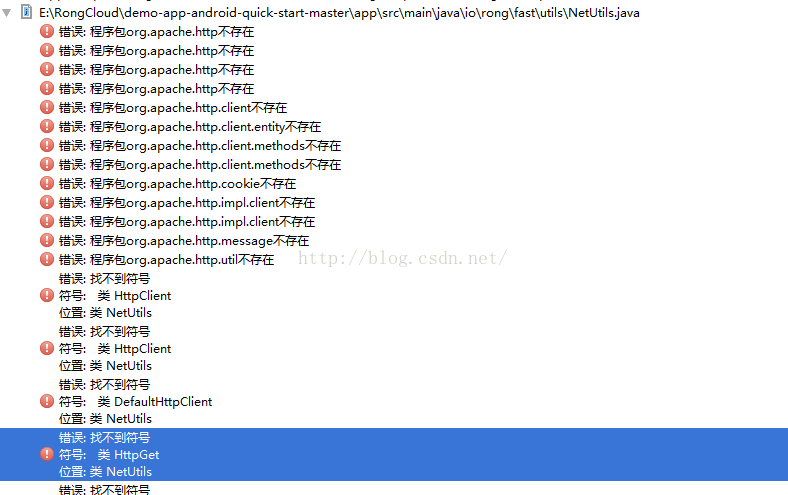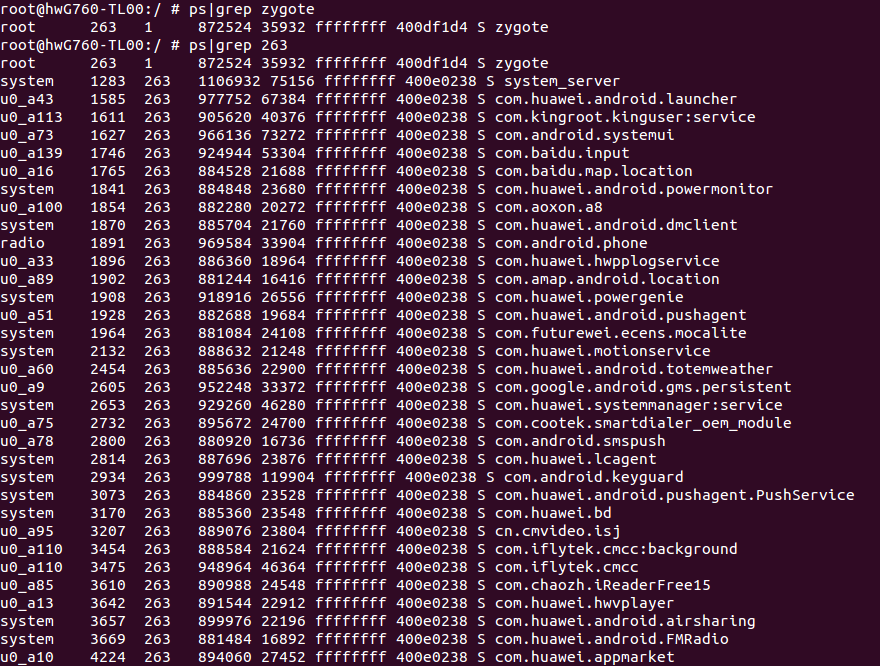編輯:關於Android編程
Android的消息機制主要指 Handler 的運行機制,Handler的運行需要底層的MessageQueue 和 Looper 的支撐。
MessageQueue:消息隊列,它的內部存儲了一組消息,以隊列的形式對外提供插入和刪除的工作,其內部存儲結構采用單鏈表的數據結構來存儲消息列表。
Looper:可理解為消息循環。
由於MessageQueue只是一個消息存儲單元,不能去處理消息,而Looper會以無限循環的形式去查找是否有新的消息,如果有的話就處理,否則就一直等待著。
Looper還有一個特殊的概念,就是ThreadLocal,它的作用可以在每個線程中存儲數據。
Handler創建的時候會采用當前線程的Looper來構造消息循環系統,Handler內部需要使用ThreadLocal來獲取每個線程的Looper。ThreadLocal可以在不同的線程中互不干擾地存儲並提供數據。
注意:線程默認是沒有Looper的,如果需要使用Handler就必須為線程創建Looper。主線程,UI線程,它就是ActivityThread,ActivityThread被創建時就會初始化Looper,這也是在主線程中默認可以使用Handler的原因。
Android的UI控件不是線程安全的,如果在多線程中並發訪問可能會導致UI控件處於不可預期的狀態,如果對UI控件加鎖會有兩個確定:首先加上鎖機制會使UI訪問邏輯變得負責;其次鎖機制會降低UI的訪問效率,鎖機制會阻礙某些線程的執行。鑒於這個兩個缺點,最簡單且高效的方法就是采用單線程模型來處理UI操作,只需要通過Handler切換一下UI訪問的執行線程即可。
Handler創建完成後,其內部的 Looper 以及 MessageQueue就可以和Handler一起工作,Handler的post方法將一個 Runnable 投遞到 Handler 內部的 Looper中去處理,也可以通過send發送一個消息(post最終也是通過send來完成的)。當Handler的send方法被調用時,它會調用 MessageQueue 的 enqueueMessage 方法將這個消息放入消息隊列中,然後Looper發現有新消息到來時,就會處理這個消息,最終消息中的Runnable或者Handler的 handleMessage方法就會被調用。注意 Looper 是運行在創建Handler所在的線程中的,這樣一來Handler中的業務邏輯就可以切換到創建Handler所在的線程中去執行。
ThreadLocal是一個線程內部的數據存儲類,通過它可以在指定的線程中存儲數據,數據存儲以後,只有在指定線程中可以獲取到存儲的數據,對於其他線程來說則無法獲取到數據。
在不同線程中訪問通同一個ThreadLocal對象,通過ThreadLocal獲取的值卻是不一樣的,是因為不同線程訪問同一個ThreadLocal的get方法,ThreadLocal內部會從各自的線程中取出一個數組,然後再從數組中根據當前ThreadLocal的索引去查找出對應的 value 值。
消息隊列在 Android 中指的是 MessageQueue,MessageQueue主要包含兩個操作: 插入和讀取。
插入:enqueueMessage
boolean enqueueMessage(Message msg, long when) {
if (msg.target == null) {
throw new IllegalArgumentException("Message must have a target.");
}
if (msg.isInUse()) {
throw new IllegalStateException(msg + " This message is already in use.");
}
synchronized (this) {
if (mQuitting) {
IllegalStateException e = new IllegalStateException(
msg.target + " sending message to a Handler on a dead thread");
Log.w(TAG, e.getMessage(), e);
msg.recycle();
return false;
}
msg.markInUse();
msg.when = when;
Message p = mMessages;
boolean needWake;
if (p == null || when == 0 || when < p.when) {
// New head, wake up the event queue if blocked.
msg.next = p;
mMessages = msg;
needWake = mBlocked;
} else {
// Inserted within the middle of the queue. Usually we don't have to wake
// up the event queue unless there is a barrier at the head of the queue
// and the message is the earliest asynchronous message in the queue.
needWake = mBlocked && p.target == null && msg.isAsynchronous();
Message prev;
for (;;) {
prev = p;
p = p.next;
if (p == null || when < p.when) {
break;
}
if (needWake && p.isAsynchronous()) {
needWake = false;
}
}
msg.next = p; // invariant: p == prev.next
prev.next = msg;
}
// We can assume mPtr != 0 because mQuitting is false.
if (needWake) {
nativeWake(mPtr);
}
}
return true;
}
讀取:next,讀取本身會伴隨刪除操作
Message next() {
// Return here if the message loop has already quit and been disposed.
// This can happen if the application tries to restart a looper after quit
// which is not supported.
final long ptr = mPtr;
if (ptr == 0) {
return null;
}
int pendingIdleHandlerCount = -1; // -1 only during first iteration
int nextPollTimeoutMillis = 0;
for (;;) {
if (nextPollTimeoutMillis != 0) {
Binder.flushPendingCommands();
}
nativePollOnce(ptr, nextPollTimeoutMillis);
synchronized (this) {
// Try to retrieve the next message. Return if found.
final long now = SystemClock.uptimeMillis();
Message prevMsg = null;
Message msg = mMessages;
if (msg != null && msg.target == null) {
// Stalled by a barrier. Find the next asynchronous message in the queue.
do {
prevMsg = msg;
msg = msg.next;
} while (msg != null && !msg.isAsynchronous());
}
if (msg != null) {
if (now < msg.when) {
// Next message is not ready. Set a timeout to wake up when it is ready.
nextPollTimeoutMillis = (int) Math.min(msg.when - now, Integer.MAX_VALUE);
} else {
// Got a message.
mBlocked = false;
if (prevMsg != null) {
prevMsg.next = msg.next;
} else {
mMessages = msg.next;
}
msg.next = null;
if (DEBUG) Log.v(TAG, "Returning message: " + msg);
msg.markInUse();
return msg;
}
} else {
// No more messages.
nextPollTimeoutMillis = -1;
}
// Process the quit message now that all pending messages have been handled.
if (mQuitting) {
dispose();
return null;
}
// If first time idle, then get the number of idlers to run.
// Idle handles only run if the queue is empty or if the first message
// in the queue (possibly a barrier) is due to be handled in the future.
if (pendingIdleHandlerCount < 0
&& (mMessages == null || now < mMessages.when)) {
pendingIdleHandlerCount = mIdleHandlers.size();
}
if (pendingIdleHandlerCount <= 0) {
// No idle handlers to run. Loop and wait some more.
mBlocked = true;
continue;
}
if (mPendingIdleHandlers == null) {
mPendingIdleHandlers = new IdleHandler[Math.max(pendingIdleHandlerCount, 4)];
}
mPendingIdleHandlers = mIdleHandlers.toArray(mPendingIdleHandlers);
}
// Run the idle handlers.
// We only ever reach this code block during the first iteration.
for (int i = 0; i < pendingIdleHandlerCount; i++) {
final IdleHandler idler = mPendingIdleHandlers[i];
mPendingIdleHandlers[i] = null; // release the reference to the handler
boolean keep = false;
try {
keep = idler.queueIdle();
} catch (Throwable t) {
Log.wtf(TAG, "IdleHandler threw exception", t);
}
if (!keep) {
synchronized (this) {
mIdleHandlers.remove(idler);
}
}
}
// Reset the idle handler count to 0 so we do not run them again.
pendingIdleHandlerCount = 0;
// While calling an idle handler, a new message could have been delivered
// so go back and look again for a pending message without waiting.
nextPollTimeoutMillis = 0;
}
}
next方法是一個無限循環的方法,如果消息隊列中沒有消息,那麼 next 方法會一直阻塞在這裡,當有消息到來時,next方法會返回這條消息並將其從單鏈表中移除。
Looper在 Android 的消息機制中扮演者消息循環的角色,它會不停地從MessageQueue中查看是否有新消息,如果有新消息就立刻處理,否則就一直阻塞在那裡。
它的構造方法,創建一個MessageQueue即消息隊列,然後將當前線程的對象保存起來:
private Looper(boolean quitAllowed) {
mQueue = new MessageQueue(quitAllowed);
mThread = Thread.currentThread();
}
Handler 的工作需要 Looper,沒有 Looper 的線程就會報錯,可以通過 Looper.prepare()為當前線程創建一個Looper,接著通過Looper.loop()來開啟消息循環:
new Thread("Thread#2"){
@Override
public void run() {
Looper.prepare();
Handler handler = new Handler();
Looper.loop();
}
}.start();
Looper除了 prepare 方法外,還提供了 prepareMainLooper 方法,主要給 ActivityThread 創建 Looper 使用,Looper 還提供一個 getMainLooper() 方法,可以在任何地方獲取到主線程的 Looper。
Looper 還提供 quite 和 quitSafely 來退出一個 Looper, 二者區別是:quit 會直接退出Looper,而 quitSafely 只是設定一個退出標記,然後把消息隊列中的已有消息處理完畢後才安全退出。
Looper 退出後,通過 Handler 發送的消息會失敗,這時Handler的send方法會返回false。
在子線程中,如果手動為其創建了 Looper ,那麼在所有的事情完成以後應該調用 quit 方法來終止消息循環,否則這個子線程就會一直處於等待的狀態,而如果退出 Looper 以後,這個線程就會立刻終止,因此建議不需要的時候終止 Looper 。
Looper 最重要的一個方法就是 loop(),只有調用 loop 方法,消息循環系統才會真正地起作用:
public static void loop() {
final Looper me = myLooper();
if (me == null) {
throw new RuntimeException("No Looper; Looper.prepare() wasn't called on this thread.");
}
final MessageQueue queue = me.mQueue;
// Make sure the identity of this thread is that of the local process,
// and keep track of what that identity token actually is.
Binder.clearCallingIdentity();
final long ident = Binder.clearCallingIdentity();
for (;;) {
Message msg = queue.next(); // might block
if (msg == null) {
// No message indicates that the message queue is quitting.
return;
}
// This must be in a local variable, in case a UI event sets the logger
Printer logging = me.mLogging;
if (logging != null) {
logging.println(">>>>> Dispatching to " + msg.target + " " +
msg.callback + ": " + msg.what);
}
msg.target.dispatchMessage(msg);
if (logging != null) {
logging.println("<<<<< Finished to " + msg.target + " " + msg.callback);
}
// Make sure that during the course of dispatching the
// identity of the thread wasn't corrupted.
final long newIdent = Binder.clearCallingIdentity();
if (ident != newIdent) {
Log.wtf(TAG, "Thread identity changed from 0x"
+ Long.toHexString(ident) + " to 0x"
+ Long.toHexString(newIdent) + " while dispatching to "
+ msg.target.getClass().getName() + " "
+ msg.callback + " what=" + msg.what);
}
msg.recycleUnchecked();
}
}
loop 方法是一個死循環,唯一跳出循環的方式就是 MessageQueue 的 next 方法返回了 null。
當Looper的 quit 方法調用時,Looper 就會調用 MessageQueue 的 quit 或者 quitSafely 方法來通知消息隊列退出,當消息隊列被標記為退出狀態時,它的next方法就會返回null,也就是說 Looper 必須退出,否則 loop 方法就會一直循環下去。
loop 方法會調用 MessageQueue 的 next 方法來獲取新消息,而next是一個阻塞操作,當沒有消息時,next 方法會一直阻塞在那裡,這也導致 loop 方法一直阻塞在那裡。
如果 MessageQueue 的 next 方法返回了新消息,Looper 會處理這條消息:msg.target.dispatchMessage(msg);這裡的msg.target是發送這條消息的 Handler 對象,這樣Handler發送的消息最終又交給它的dispatchMessage方法來處理,不同的是,Handler的dispatchMessage方法是在創建Handler時所使用的 Looper 中執行的,這樣就成功地將代碼邏輯切換到指定的線程中去執行。
Handler主要包含消息的發送和接收過程。消息的發送可以通過 post 的一系列方法以及 send 的一系列方法來實現。
public final boolean sendMessage(Message msg)
{
return sendMessageDelayed(msg, 0);
}
public final boolean sendMessageDelayed(Message msg, long delayMillis)
{
if (delayMillis < 0) {
delayMillis = 0;
}
return sendMessageAtTime(msg, SystemClock.uptimeMillis() + delayMillis);
}
public boolean sendMessageAtTime(Message msg, long uptimeMillis) {
MessageQueue queue = mQueue;
if (queue == null) {
RuntimeException e = new RuntimeException(
this + " sendMessageAtTime() called with no mQueue");
Log.w("Looper", e.getMessage(), e);
return false;
}
return enqueueMessage(queue, msg, uptimeMillis);
}
private boolean enqueueMessage(MessageQueue queue, Message msg, long uptimeMillis) {
msg.target = this;
if (mAsynchronous) {
msg.setAsynchronous(true);
}
return queue.enqueueMessage(msg, uptimeMillis);
}
Handler 發送消息的過程僅僅是向消息隊列中插入一條消息,MessageQueue 的 next 方法就會返回這條消息給 Looper,Looper 接收到消息就開始處理了,最終消息由 Looper 交由 Handler 處理,即 Handler 的 dispatchMessage 方法會被調用,這時 Handler 就會進入消息處理階段,dispatchMessage 的實現如下:
public void dispatchMessage(Message msg) {
if (msg.callback != null) {
handleCallback(msg);
} else {
if (mCallback != null) {
if (mCallback.handleMessage(msg)) {
return;
}
}
handleMessage(msg);
}
}
首先,檢查Message的callback是否為null,不為null就通過handleCallback(msg)來處理消息,Message的callback是一個 Runnable 對象,實際上就是 Handler的post方法所傳遞的 Runnable 參數。
private static void handleCallback(Message message) {
message.callback.run();
}
其次,檢查 mCallback 是否為 null,不為 null 就調用 mCallback 的handleMessage方法,這樣就不用派生Handler的子類
Handler handler = new Handler(callback);
最後,調用 Handler 的 handleMessage 方法來處理消息。
Handler 還有一個特殊的構造方法,就是通過一個特定的 Looper 來構造 Handler,它的實現如下:
public Handler(Looper looper) {
this(looper, null, false);
}
public Handler(Looper looper, Callback callback, boolean async) {
mLooper = looper;
mQueue = looper.mQueue;
mCallback = callback;
mAsynchronous = async;
}
下面看一下 Handler 的默認構造方法:
public Handler(Callback callback, boolean async) {
if (FIND_POTENTIAL_LEAKS) {
final Class klass = getClass();
if ((klass.isAnonymousClass() || klass.isMemberClass() || klass.isLocalClass()) &&
(klass.getModifiers() & Modifier.STATIC) == 0) {
Log.w(TAG, "The following Handler class should be static or leaks might occur: " +
klass.getCanonicalName());
}
}
mLooper = Looper.myLooper();
if (mLooper == null) {
throw new RuntimeException(
"Can't create handler inside thread that has not called Looper.prepare()");
}
mQueue = mLooper.mQueue;
mCallback = callback;
mAsynchronous = async;
}
如果當前線程沒有 Looper 的話,就會拋出 “Can’t create handler inside thread that has not called Looper.prepare()”異常。
Android 的主線程就是 ActivityThread,主線程的入口方法為 main,在 main 方法中通過 Looper.prepareMainLooper()來創建主線程的 Looper 以及 MessageQueue,並通過 Looper.loop() 來開啟主線程的消息循環。
public static void main(String[] args) {
Trace.traceBegin(Trace.TRACE_TAG_ACTIVITY_MANAGER, "ActivityThreadMain");
SamplingProfilerIntegration.start();
// CloseGuard defaults to true and can be quite spammy. We
// disable it here, but selectively enable it later (via
// StrictMode) on debug builds, but using DropBox, not logs.
CloseGuard.setEnabled(false);
Environment.initForCurrentUser();
// Set the reporter for event logging in libcore
EventLogger.setReporter(new EventLoggingReporter());
AndroidKeyStoreProvider.install();
// Make sure TrustedCertificateStore looks in the right place for CA certificates
final File configDir = Environment.getUserConfigDirectory(UserHandle.myUserId());
TrustedCertificateStore.setDefaultUserDirectory(configDir);
Process.setArgV0("");
Looper.prepareMainLooper();
ActivityThread thread = new ActivityThread();
thread.attach(false);
if (sMainThreadHandler == null) {
sMainThreadHandler = thread.getHandler();
}
if (false) {
Looper.myLooper().setMessageLogging(new
LogPrinter(Log.DEBUG, "ActivityThread"));
}
// End of event ActivityThreadMain.
Trace.traceEnd(Trace.TRACE_TAG_ACTIVITY_MANAGER);
Looper.loop();
throw new RuntimeException("Main thread loop unexpectedly exited");
}
}
主線程消息循環開始以後,ActivityThread還需要一個 Handler 來和消息隊列進行交互,這個Handler就是ActivitThread.H,它內部定義了一組消息類型,主要包含了四大組件的啟動和停止過程:
private class H extends Handler {
public static final int LAUNCH_ACTIVITY = 100;
public static final int PAUSE_ACTIVITY = 101;
public static final int PAUSE_ACTIVITY_FINISHING= 102;
public static final int STOP_ACTIVITY_SHOW = 103;
public static final int STOP_ACTIVITY_HIDE = 104;
public static final int SHOW_WINDOW = 105;
public static final int HIDE_WINDOW = 106;
public static final int RESUME_ACTIVITY = 107;
public static final int SEND_RESULT = 108;
public static final int DESTROY_ACTIVITY = 109;
public static final int BIND_APPLICATION = 110;
public static final int EXIT_APPLICATION = 111;
public static final int NEW_INTENT = 112;
public static final int RECEIVER = 113;
public static final int CREATE_SERVICE = 114;
public static final int SERVICE_ARGS = 115;
public static final int STOP_SERVICE = 116;
...
}
ActivityThread 通過 ApplicationThread 和 AMS 進行進程間通信,AMS 以進程間通信的方式完成。 ActivityThread的請求會回調 ApplicationThread 中的Binder 方法,然後ApplicationThread 會向 H 發送消息,H 收到消息後會將 ApplicationThread 中的邏輯切換到 ActivityThread 中去執行,即切換到主線程中去執行,這個過程就是主線程的消息循環模型。
 Android程序報錯程序包org.apache.http不存在問題的解決方法
Android程序報錯程序包org.apache.http不存在問題的解決方法
Android Studio 2.1中使用 Android SDK 6.0(API 23),加載融雲Demo時,報錯:解決辦法:Android 6.0(api 23)已經
 在Android用ZXing.jar識別二維碼的精簡版(簡化了配置和代碼)
在Android用ZXing.jar識別二維碼的精簡版(簡化了配置和代碼)
最近公司做了一款OTP令牌激活的產品,由於之前激活手機令牌需要輸入很多的激活信息才能進行激活。經過一段使用後,發現易用性不是很強,考慮如果加入二維碼的的掃碼功能豈不是大大
 Zygote的源碼解析
Zygote的源碼解析
1.什麼是Zygote?在Android中所有的應用程序進程,以及用來運行系統關鍵服務的System進程都是有Zygote進程負責創建的,因此我們就叫他受精卵,畢竟它真的
 listview固定頭標
listview固定頭標
由於近期需要這個listview固定頭部很簡單就是ListView增加一個headView頭部然後根據滑動的距離判斷是否顯示隱藏了的按鈕效果圖接下來就是顯示代碼了首先是布